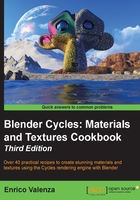
Preface
Since the Blender interface and code were rewritten from scratch, starting with the 2.5 series and throughout the production of the open movie Sintel, a lot of good things have happened to the famous open source 3D modeling and animation suite.
One of them has been the announcement (in April 2011) of Cycles, a new rendering engine developed by Brecht Van Lommel with the goal of modernizing Blender's shading and rendering systems. It could be used as alternative to the Blender Internal rendering engine.
Cycles has finally been integrated with Blender with the 2.61 release, as an add-on that is a Python script, enabled in the Preferences panel by default. It suffices to set this as the active render engine in the User Interface main header.
While Blender Internal is a scan-line rendering engine, Cycles is a physically based path tracer. This approach allows simplification of material creation, support for Global Illumination, and much more realism in the results.
But the best feature of Cycles is probably the rendering you get in the 3D viewport. When you set the Draw mode of any 3D viewport to Rendered, an interactive rendering starts in the viewport. From then onwards, the pre-visualization rendering of the scene is continuously updated almost in real time (depending on the power of your graphics card) as a material, a light, or object. Even the entire scene can be modified.
Using Cycles, a lot of astonishing images and a few animations have been produced, both for testing and for real productions. You can find most of them at the Blender Artists forum (http://blenderartists.org/forum/), but it's enough to mention Tears of Steel, the fifth open movie produced by the Blender Foundation with the codename Mango—a short science-fiction movie entirely rendered in Cycles to accomplish the visual effects; well, not entirely, but actually 95 percent. The team used Blender Internal for the then unsupported features. In fact, being included in the same software also provided an integrated compositor. Both the Blender Internal and the Cycles render engines can actually be paired to make full use of all the needed features.
If you are not a beginner in Blender, you are probably already using your customized version of the User Interface, with your personal preferences as add-ons, modified screens, and all that is already set in the User Preferences panel.
In this book, we'll start our workflow with the Factory Settings, which is the basic interface and preferences situation we have the very first time we start Blender, just after downloading the ZIP file and uncompressing it into some location on our hard drive.
Instructions about any required add-on to be enabled or particular settings are provided in the Getting ready section of the recipes.
Note
In the making of this Cookbook, I've used versions of Blender from 2.71 to 2.73. Therefore, you could sometimes find a screenshot showing buttons or features not appearing in other pictures; for example, there are differences in the Node Editor toolbar between versions 2.71 and 2.72, as shown in the following screenshot (actually, this is only relevant to Cycles):

Things like this shouldn't be an issue, however, because there are no big differences in these three versions; only improvements. Moreover, the files provided have been tested under the three versions. Obviously, new features introduced in version 2.73 are not available in the previous versions, so always use the last official Blender release.
You can see a list of the new features available in version 2.73, at http://wiki.blender.org/index.php/Dev:Ref/Release_Notes/2.73.